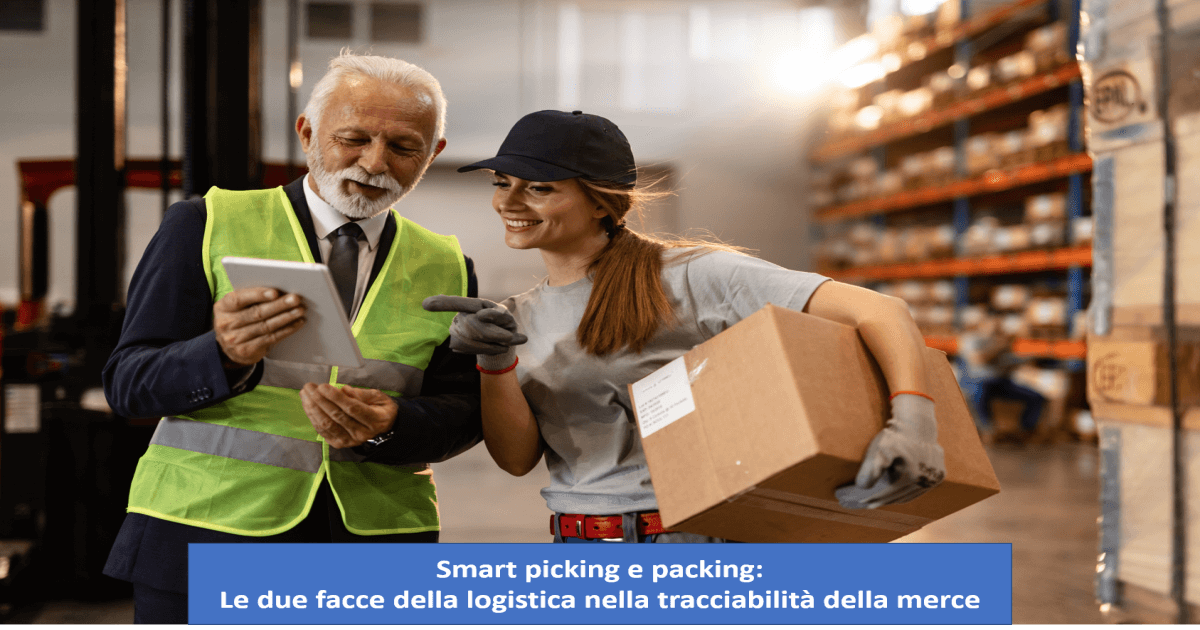Smart Picking and Packing: the two sides of warehouse logistics in goods traceability
The word “smart” has become the most commonly used synonym in the context of Industry 4.0 related solutions. ‘Smart’ means fast, intelligent industry and, above all, it means ‘time-saving’.
Warehouse logistics was one of the first areas in which, since the 1990s, mobile devices have been used to automate the processes of receiving, picking and shipping goods.
Technological developments have led to the increasing use of ‘smart factory’ solutions, which, according to the definition, allow the use of hands-free devices and in many cases allow you to interact directly with your voice.

Smart Picking for the intelligent industry
Smart picking (picking of materials for production or shipment) is now an almost established method in very large warehouses and smart industries, because they allow very high picking frequencies. The most commonly used tools are ‘smart gloves’, gloves equipped with a wifi or bluetooth barcode reader, ‘smart glasses’ that act as a screen and headsets with a microphone for voice interaction. Operators now look like bionic persons equipped with ‘add-on’ devices to speed up operations. In addition, these systems equipped with a wifi network connection allow operators’ movements to be monitored. They also make it possible to optimise the movements themselves and to obtain, by a kind of reverse engineering, the best routes to propose to the operators when they pick up the material from the shelves, in the true philosophy of intelligent industry.
Other particularly efficient (smart) systems for picking activities are ‘pick & light’ systems that allow simultaneous picking of several orders by switching on a light at the point where the material is to be deposited. This is an example of what a smart factory means.
Not to mention the “smart labels”, the RFID-based tags that help a great deal in the traceability of goods during picking (but also during inventory and dispatch) because they can be recognised at a distance of a few metres, thus ensuring that they are moving in the correct direction. They are also very helpful in cases where visually the part cannot be located; in this case the ‘search’ system (terminal equipped with an rfid antenna), and here the definition of a smart factory is even clearer, increases the sound intensity emitted the closer you get to the part.
Smart packing in smart factories
We have talked about “picking”, which is the initial phase of shipping the goods, and we now come to the final part of the shipment, i.e. the moment of “packing”, two aspects which, if optimised, allow enormous cost savings not only in terms of time, but also in terms of the drastic reduction of shipping errors in the smart industry.
As part of its proposals, Sygest has long promoted the Photo Packing List solution. Created to help with the customs clearance of goods, by integrating photos of the shipped parts into the document, it was then realised that it could also be used internally within the company to guarantee the security of operations with the certainty that all parts were shipped and that they were the correct ones.
With a view to proposing solutions which are always innovative and in step with technology, and to fulfil the pure definition of a smart factory, Sygest proposes its “smart packing” by adding the use of “smart labels” on the packaging in the management of the Packing List Photo accompanying the QR code which allows the contents of the packaging itself to be seen directly through the code-related photos.
Smart labels can be used during shipping to ensure that everything prepared is shipped, but they also become very useful when used to ship pallets to an assembly site to search for a part that is not visually identifiable. The terminal equipped with an RFID antenna behaves like a dowser’s rod by signalling by sound or vibration or colour that it is approaching the part (in a similar way to what we have seen for tracking down parts during picking).
As far as the ease of preparing the packing list is concerned, Sygest is currently testing the inclusion of ‘hands-free’ tools, in particular wearing a ‘smart’ scanner on one wrist and an android terminal (similar to a smartwatch) on the other, which allows photos to be taken and is equipped with a 2.8″ screen on which to select the packing list, scroll through the rows and display the photos themselves.
For those who have to handle large quantities of consignments and therefore find it inconvenient to have a hand-held terminal that they have to constantly pick up and put down, Sygest’s Smart Packing List Photo provides remarkable ergonomics, making their work easier and becoming a real smart industry.